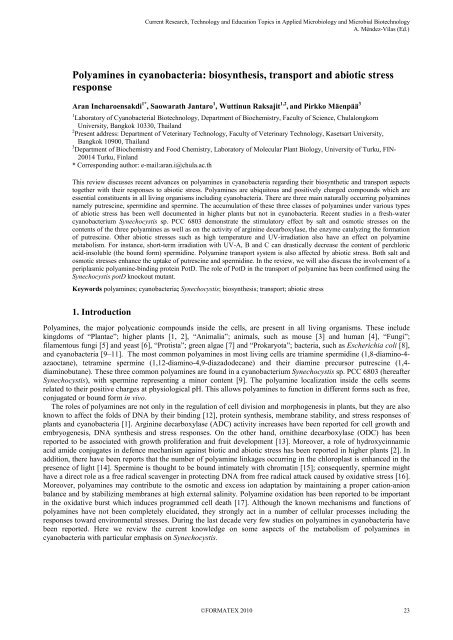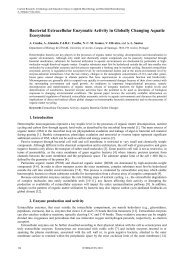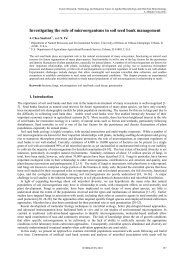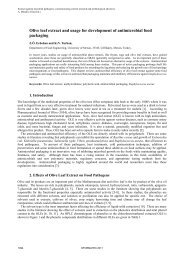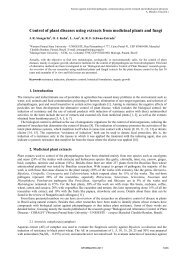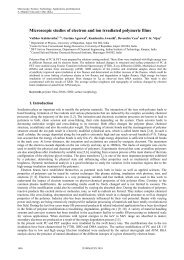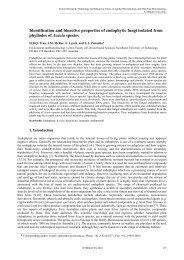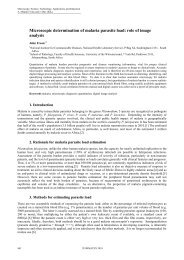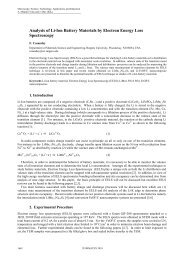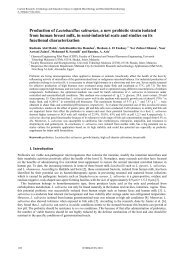Polyamines in cyanobacteria - Formatex Research Center
Polyamines in cyanobacteria - Formatex Research Center
Polyamines in cyanobacteria - Formatex Research Center
You also want an ePaper? Increase the reach of your titles
YUMPU automatically turns print PDFs into web optimized ePapers that Google loves.
<strong>Polyam<strong>in</strong>es</strong> <strong>in</strong> <strong>cyanobacteria</strong>: biosynthesis, transport and abiotic stress<br />
response<br />
Aran Incharoensakdi 1* , Saowarath Jantaro 1 , Wutt<strong>in</strong>un Raksajit 1,2 , and Pirkko Mäenpää 3<br />
1<br />
Laboratory of Cyanobacterial Biotechnology, Department of Biochemistry, Faculty of Science, Chulalongkorn<br />
University, Bangkok 10330, Thailand<br />
2<br />
Present address: Department of Veter<strong>in</strong>ary Technology, Faculty of Veter<strong>in</strong>ary Technology, Kasetsart University,<br />
Bangkok 10900, Thailand<br />
3<br />
Department of Biochemistry and Food Chemistry, Laboratory of Molecular Plant Biology, University of Turku, FIN-<br />
20014 Turku, F<strong>in</strong>land<br />
* Correspond<strong>in</strong>g author: e-mail:aran.i@chula.ac.th<br />
This review discusses recent advances on polyam<strong>in</strong>es <strong>in</strong> <strong>cyanobacteria</strong> regard<strong>in</strong>g their biosynthetic and transport aspects<br />
together with their responses to abiotic stress. <strong>Polyam<strong>in</strong>es</strong> are ubiquitous and positively charged compounds which are<br />
essential constituents <strong>in</strong> all liv<strong>in</strong>g organisms <strong>in</strong>clud<strong>in</strong>g <strong>cyanobacteria</strong>. There are three ma<strong>in</strong> naturally occurr<strong>in</strong>g polyam<strong>in</strong>es<br />
namely putresc<strong>in</strong>e, spermid<strong>in</strong>e and sperm<strong>in</strong>e. The accumulation of these three classes of polyam<strong>in</strong>es under various types<br />
of abiotic stress has been well documented <strong>in</strong> higher plants but not <strong>in</strong> <strong>cyanobacteria</strong>. Recent studies <strong>in</strong> a fresh-water<br />
cyanobacterium Synechocystis sp. PCC 6803 demonstrate the stimulatory effect by salt and osmotic stresses on the<br />
contents of the three polyam<strong>in</strong>es as well as on the activity of arg<strong>in</strong><strong>in</strong>e decarboxylase, the enzyme catalyz<strong>in</strong>g the formation<br />
of putresc<strong>in</strong>e. Other abiotic stresses such as high temperature and UV-irradiation also have an effect on polyam<strong>in</strong>e<br />
metabolism. For <strong>in</strong>stance, short-term irradiation with UV-A, B and C can drastically decrease the content of perchloric<br />
acid-<strong>in</strong>soluble (the bound form) spermid<strong>in</strong>e. Polyam<strong>in</strong>e transport system is also affected by abiotic stress. Both salt and<br />
osmotic stresses enhance the uptake of putresc<strong>in</strong>e and spermid<strong>in</strong>e. In the review, we will also discuss the <strong>in</strong>volvement of a<br />
periplasmic polyam<strong>in</strong>e-b<strong>in</strong>d<strong>in</strong>g prote<strong>in</strong> PotD. The role of PotD <strong>in</strong> the transport of polyam<strong>in</strong>e has been confirmed us<strong>in</strong>g the<br />
Synechocystis potD knockout mutant.<br />
Keywords polyam<strong>in</strong>es; <strong>cyanobacteria</strong>; Synechocystis; biosynthesis; transport; abiotic stress<br />
1. Introduction<br />
_______________________________________________________________________________________<br />
<strong>Polyam<strong>in</strong>es</strong>, the major polycationic compounds <strong>in</strong>side the cells, are present <strong>in</strong> all liv<strong>in</strong>g organisms. These <strong>in</strong>clude<br />
k<strong>in</strong>gdoms of “Plantae”; higher plants [1, 2], “Animalia”; animals, such as mouse [3] and human [4], “Fungi”;<br />
filamentous fungi [5] and yeast [6], “Protista”; green algae [7] and “Prokaryota”; bacteria, such as Escherichia coli [8],<br />
and <strong>cyanobacteria</strong> [9–11]. The most common polyam<strong>in</strong>es <strong>in</strong> most liv<strong>in</strong>g cells are triam<strong>in</strong>e spermid<strong>in</strong>e (1,8-diam<strong>in</strong>o-4azaoctane),<br />
tetram<strong>in</strong>e sperm<strong>in</strong>e (1,12-diam<strong>in</strong>o-4,9-diazadodecane) and their diam<strong>in</strong>e precursor putresc<strong>in</strong>e (1,4diam<strong>in</strong>obutane).<br />
These three common polyam<strong>in</strong>es are found <strong>in</strong> a cyanobacterium Synechocystis sp. PCC 6803 (hereafter<br />
Synechocystis), with sperm<strong>in</strong>e represent<strong>in</strong>g a m<strong>in</strong>or content [9]. The polyam<strong>in</strong>e localization <strong>in</strong>side the cells seems<br />
related to their positive charges at physiological pH. This allows polyam<strong>in</strong>es to function <strong>in</strong> different forms such as free,<br />
conjugated or bound form <strong>in</strong> vivo.<br />
The roles of polyam<strong>in</strong>es are not only <strong>in</strong> the regulation of cell division and morphogenesis <strong>in</strong> plants, but they are also<br />
known to affect the folds of DNA by their b<strong>in</strong>d<strong>in</strong>g [12], prote<strong>in</strong> synthesis, membrane stability, and stress responses of<br />
plants and <strong>cyanobacteria</strong> [1]. Arg<strong>in</strong><strong>in</strong>e decarboxylase (ADC) activity <strong>in</strong>creases have been reported for cell growth and<br />
embryogenesis, DNA synthesis and stress responses. On the other hand, ornith<strong>in</strong>e decarboxylase (ODC) has been<br />
reported to be associated with growth proliferation and fruit development [13]. Moreover, a role of hydroxyc<strong>in</strong>namic<br />
acid amide conjugates <strong>in</strong> defence mechanism aga<strong>in</strong>st biotic and abiotic stress has been reported <strong>in</strong> higher plants [2]. In<br />
addition, there have been reports that the number of polyam<strong>in</strong>e l<strong>in</strong>kages occurr<strong>in</strong>g <strong>in</strong> the chloroplast is enhanced <strong>in</strong> the<br />
presence of light [14]. Sperm<strong>in</strong>e is thought to be bound <strong>in</strong>timately with chromat<strong>in</strong> [15]; consequently, sperm<strong>in</strong>e might<br />
have a direct role as a free radical scavenger <strong>in</strong> protect<strong>in</strong>g DNA from free radical attack caused by oxidative stress [16].<br />
Moreover, polyam<strong>in</strong>es may contribute to the osmotic and excess ion adaptation by ma<strong>in</strong>ta<strong>in</strong><strong>in</strong>g a proper cation-anion<br />
balance and by stabiliz<strong>in</strong>g membranes at high external sal<strong>in</strong>ity. Polyam<strong>in</strong>e oxidation has been reported to be important<br />
<strong>in</strong> the oxidative burst which <strong>in</strong>duces programmed cell death [17]. Although the known mechanisms and functions of<br />
polyam<strong>in</strong>es have not been completely elucidated, they strongly act <strong>in</strong> a number of cellular processes <strong>in</strong>clud<strong>in</strong>g the<br />
responses toward environmental stresses. Dur<strong>in</strong>g the last decade very few studies on polyam<strong>in</strong>es <strong>in</strong> <strong>cyanobacteria</strong> have<br />
been reported. Here we review the current knowledge on some aspects of the metabolism of polyam<strong>in</strong>es <strong>in</strong><br />
<strong>cyanobacteria</strong> with particular emphasis on Synechocystis.
_______________________________________________________________________________________<br />
2. Polyam<strong>in</strong>e Biosynthesis<br />
2.1 Current understand<strong>in</strong>g of biosynthesis pathway of polyam<strong>in</strong>es<br />
In plants and bacteria, putresc<strong>in</strong>e is formed either by direct decarboxylation of L-ornith<strong>in</strong>e by the enzyme ornith<strong>in</strong>e<br />
decarboxylase (ODC; EC 4.1.1.17), or by decarboxylation of arg<strong>in</strong><strong>in</strong>e by arg<strong>in</strong><strong>in</strong>e decarboxylase (ADC; EC 4.1.1.19)<br />
via agmat<strong>in</strong>e and N-carbamoylputresc<strong>in</strong>e <strong>in</strong>termediates (Fig. 1a). In mammals and fungi, only one pathway (ODC<br />
reaction) leads to putresc<strong>in</strong>e formation [18]. The synthesis of spermid<strong>in</strong>e and sperm<strong>in</strong>e is accomplished by the<br />
sequential addition of an am<strong>in</strong>opropyl group onto putresc<strong>in</strong>e and spermid<strong>in</strong>e, respectively, <strong>in</strong> reactions catalyzed by the<br />
enzyme spermid<strong>in</strong>e synthase (EC 2.5.1.16) and sperm<strong>in</strong>e synthase (EC 2.5.1.22). The am<strong>in</strong>opropyl group is donated by<br />
decarboxylated S-adenosylmethion<strong>in</strong>e (SAM), which is produced by S-adenosylmethion<strong>in</strong>e decarboxylase (SAMDC;<br />
EC 4.1.1.50). Until now, a large number of genes for polyam<strong>in</strong>e biosynthesis have been isolated from Arabidopsis<br />
(http://www.arabidopsis.org/) <strong>in</strong> contrast to only a limited number of genes for <strong>cyanobacteria</strong> (http://genome.kazusa.<br />
or.jp/cyanobase/) (Table 1).<br />
Although Arabidopsis genes are identified with strong homology to those <strong>in</strong> the photosynthetic bacterium<br />
Synechocystis [19], only four separate genes are found that correlate to polyam<strong>in</strong>e biosynthesis <strong>in</strong> Synechocystis, as well<br />
as two related genes <strong>in</strong> Anabaena 7120 (Table 1). So far, the genetic <strong>in</strong>formation of Synechocystis reveals that the<br />
dom<strong>in</strong>ant pathway to produce putresc<strong>in</strong>e is via the decarboxylation of arg<strong>in</strong><strong>in</strong>e by ADC with agmat<strong>in</strong>e as an<br />
<strong>in</strong>termediate (Fig. 1b). Recent studies on arg<strong>in</strong><strong>in</strong>e catabolism <strong>in</strong> <strong>cyanobacteria</strong> have found the existence of ADC <strong>in</strong> all<br />
24 stra<strong>in</strong>s of <strong>cyanobacteria</strong> <strong>in</strong>clud<strong>in</strong>g Synechocystis [20]. Even though ornith<strong>in</strong>e can be detected by the action of<br />
arg<strong>in</strong>ase on arg<strong>in</strong><strong>in</strong>e, the conversion of ornith<strong>in</strong>e to putresc<strong>in</strong>e is unlikely due to the lack of ODC <strong>in</strong> <strong>cyanobacteria</strong>.<br />
<strong>Polyam<strong>in</strong>es</strong> and the activity of ADC are detectable <strong>in</strong> Synechocystis. SAMDC activity is also detectable <strong>in</strong><br />
Synechocystis; however, its correspond<strong>in</strong>g gene is not found <strong>in</strong> the genome sequence. Similarly, no gene sequences for<br />
spermid<strong>in</strong>e and sperm<strong>in</strong>e synthases are found despite the detectable spermid<strong>in</strong>e and sperm<strong>in</strong>e contents <strong>in</strong> Synechocystis<br />
[9]. This <strong>in</strong>dicates that both spermid<strong>in</strong>e and sperm<strong>in</strong>e are synthesized by some other enzymes or these two polyam<strong>in</strong>es<br />
arise from the degradation of some related metabolites.<br />
a)<br />
Fig. 1 (a) The pathway of polyam<strong>in</strong>e synthesis <strong>in</strong> higher plants (modified from [1]). 1, Arg<strong>in</strong><strong>in</strong>e decarboxylase (ADC); 2, Arg<strong>in</strong>ase;<br />
3, Ornith<strong>in</strong>e decarboxylase (ODC); 4, Agmat<strong>in</strong>e im<strong>in</strong>ohydrolase; 5, N-carbamoyl putresc<strong>in</strong>e amidohydrolase; 6, Sadenosylmethion<strong>in</strong>e<br />
decarboxylase (SAMDC); 7, Spermid<strong>in</strong>e synthase; 8, Sperm<strong>in</strong>e synthase; 9, SAM synthase; 10, ACC synthase;<br />
11, ACC oxidase; 12, Ornith<strong>in</strong>e transcarbamylase; 13, Arg<strong>in</strong><strong>in</strong>e synthase. (b) The pathway of polyam<strong>in</strong>e synthesis <strong>in</strong> cyanobacterium<br />
Synechocystis sp. PCC 6803.<br />
From Table 1 and Fig. 1b together with all available data until now, ADC seems to be the most important enzyme for<br />
polyam<strong>in</strong>e biosynthetic pathway <strong>in</strong> <strong>cyanobacteria</strong>. Based on structural model<strong>in</strong>g, Synechocystis ADCs have a putative<br />
extra doma<strong>in</strong>, which might be <strong>in</strong>volved <strong>in</strong> the posttranslational regulation of ADC activity <strong>in</strong> Synechocystis. Moreover,<br />
two symmetric <strong>in</strong>ter-subunit disulfide bonds seem to stabilize the dimeric structure of ADCs [21].<br />
b)
Table 1 Genes related to polyam<strong>in</strong>e biosynthesis <strong>in</strong> plant [75] and <strong>cyanobacteria</strong> based on Cyanobase<br />
Arabidopsis [75] Synechocystis 6803 Anabaena 7120<br />
Arg<strong>in</strong><strong>in</strong>e decarboxylase adc1, adc2 adc1 (slr1312),<br />
adc2 (slr0662)<br />
Arg<strong>in</strong>ase aqrgah1, argah2 speB1 (sll0228) -<br />
all3401<br />
Agmat<strong>in</strong>ase - speB2 (sll1077) alr2310<br />
Ornith<strong>in</strong>e decarboxylase - - -<br />
Agmat<strong>in</strong>e im<strong>in</strong>ohydrolase aih - -<br />
N-carbamoyl putresc<strong>in</strong>e<br />
amidohydrolase<br />
S-adenosylmethion<strong>in</strong>e<br />
decarboxylase<br />
cpa - -<br />
samdc1, samdc2 - -<br />
Spermid<strong>in</strong>e synthase spds1, spds2 - -<br />
Sperm<strong>in</strong>e synthase spms, acl5 - -<br />
SAM synthase - - -<br />
Ornith<strong>in</strong>e transcarbamylase - - -<br />
Arg<strong>in</strong><strong>in</strong>e synthase - - -<br />
On the other hand, the mammalian ADC differs from ADC isoforms expressed <strong>in</strong> plants, bacteria, or Caenorhabditis<br />
elegans and is dist<strong>in</strong>ct from ODC [22]. The distribution of both ADC and ODC enzymes <strong>in</strong> different organism species<br />
is regulated <strong>in</strong> a developmental and tissue specific manner [23]. The location of ODC enzyme <strong>in</strong> animals and plants is<br />
observed <strong>in</strong> both cytoplasm and nucleus [24] whereas ADC is localized <strong>in</strong> chloroplasts associated with the thylakoid<br />
membrane [25]. In plants, SAM, aside from participat<strong>in</strong>g <strong>in</strong> numerous transmethylation reactions, as it does <strong>in</strong> other<br />
organisms, is also a precursor of the plant hormone ethylene. A variety of other related compounds have been found <strong>in</strong><br />
plants, <strong>in</strong>clud<strong>in</strong>g cadaver<strong>in</strong>e. Cadaver<strong>in</strong>e diam<strong>in</strong>e is synthesized predom<strong>in</strong>antly as the result of lys<strong>in</strong>e decarboxylase<br />
(LDC; EC 4.1.1.18) activity. This diam<strong>in</strong>e is not as widely distributed as putresc<strong>in</strong>e and is ma<strong>in</strong>ly found <strong>in</strong><br />
Legum<strong>in</strong>oseae and <strong>in</strong> the flowers of Arum lilies [26]. However, recently we have found cadaver<strong>in</strong>e <strong>in</strong> Synechocystis<br />
cells under either ionic or osmotic stress conditions. This is consistent with the presence of a gene encod<strong>in</strong>g lys<strong>in</strong>e<br />
decarboxylase (sll1683) <strong>in</strong> Cyanobase. Moreover, some uncommon polyam<strong>in</strong>es <strong>in</strong>clud<strong>in</strong>g branched pentam<strong>in</strong>es,<br />
hexam<strong>in</strong>es and heptam<strong>in</strong>es have been detected <strong>in</strong> the extreme thermophilic bacteria [2].<br />
Specific <strong>in</strong>hibitors for each of these enzymes have been used <strong>in</strong> many tissues to manipulate cellular polyam<strong>in</strong>e<br />
metabolism. DL-α-difluoromethylornith<strong>in</strong>e (DFMO) is a highly effective <strong>in</strong>hibitor of all animal ornith<strong>in</strong>e<br />
decarboxylases while its effectiveness for plant ornith<strong>in</strong>e decarboxylases is quite variable. DMFO also exerts an<br />
<strong>in</strong>hibitory effect on the expression of ADC <strong>in</strong> Synechocystis. The adc transcripts decrease <strong>in</strong> cells grown <strong>in</strong> the presence<br />
of DMFO. Moreover, the <strong>in</strong>creased adc transcripts observed <strong>in</strong> cells under osmotic stress is abolished upon addition of<br />
DMFO.<br />
In most plant tissues, DL-α-difluoromethylarg<strong>in</strong><strong>in</strong>e (DFMA) and methylglyoxal bis-guanylhydrazone (MGBG) are<br />
generally quite effective <strong>in</strong> <strong>in</strong>hibit<strong>in</strong>g the activities of arg<strong>in</strong><strong>in</strong>e decarboxylase and S-adenosylmethion<strong>in</strong>e decarboxylase,<br />
respectively. S-adenosylmethion<strong>in</strong>e decarboxylase activity and transcript levels are known to <strong>in</strong>crease <strong>in</strong> actively<br />
divid<strong>in</strong>g tissues. On the other hand, due to its ability to <strong>in</strong>hibit cell division, MGBG has been widely used both <strong>in</strong><br />
animal and plant cells for basic studies as well as for therapeutic applications <strong>in</strong> cancer treatment [27].<br />
2.2 Polyam<strong>in</strong>e forms exist<strong>in</strong>g <strong>in</strong>side the cells<br />
S<strong>in</strong>ce the molecules of polyam<strong>in</strong>es are basic with positive charges at physiological pH, they may not only occur as free<br />
molecules but also as conjugates to small molecules [2] like phenolic acids (conjugated forms) and also to various<br />
macromolecules like prote<strong>in</strong>s (bound forms) [28]. Spermid<strong>in</strong>e is the most abundant free forms of polyam<strong>in</strong>es <strong>in</strong> most<br />
organisms <strong>in</strong>clud<strong>in</strong>g <strong>cyanobacteria</strong> [9] and it is present predom<strong>in</strong>antly <strong>in</strong> the cytosolic fraction [29].<br />
2.2.1 Conjugated forms<br />
_______________________________________________________________________________________<br />
Conjugated polyam<strong>in</strong>es are the most commonly found forms of polyam<strong>in</strong>es <strong>in</strong> plants. <strong>Polyam<strong>in</strong>es</strong> are conjugated by the<br />
formation of an amide l<strong>in</strong>kage, utiliz<strong>in</strong>g esters of CoA for the provision of the activated carboxyl groups [30]. The most
_______________________________________________________________________________________<br />
common conjugated polyam<strong>in</strong>es are those that are covalently l<strong>in</strong>ked to c<strong>in</strong>namic acids. The levels of conjugated<br />
polyam<strong>in</strong>es, such as hydroxyc<strong>in</strong>namic acid amides, are correlated with developmental phenomena. They accumulate <strong>in</strong><br />
roots and shoots, upon floral <strong>in</strong>itiation <strong>in</strong> tobacco. Polyam<strong>in</strong>e content <strong>in</strong>creases dur<strong>in</strong>g all three organogenic programs,<br />
especially dur<strong>in</strong>g meristemoid formation and up to the protrusion of the first organs [27]. Putresc<strong>in</strong>e ma<strong>in</strong>ly forms<br />
monomers (perchloric acid-soluble fraction) with coumaric acid, caffeoyl acid or feruloyl acid. These conjugates are of<br />
particular importance both for the regulation of polyam<strong>in</strong>e concentration <strong>in</strong>side the cell, and for their <strong>in</strong>teraction. In fact<br />
hydroxyc<strong>in</strong>namic acid bridges, through ester-ester l<strong>in</strong>kages, different cell wall polymers, essentially hemicellulose and<br />
lign<strong>in</strong> [2]. Dur<strong>in</strong>g all developmental programs, there is a possibility that the balance between the levels of free and<br />
conjugated polyam<strong>in</strong>es may contribute to growth regulation and play a role dur<strong>in</strong>g morphogenesis. Aliphatic am<strong>in</strong>es<br />
(putresc<strong>in</strong>e, spermid<strong>in</strong>e and sperm<strong>in</strong>e) appear as water-soluble forms, whereas conjugated forms with aromatic and<br />
aliphatic am<strong>in</strong>es that use each term<strong>in</strong>al am<strong>in</strong>o group to b<strong>in</strong>d c<strong>in</strong>namic acid are water-<strong>in</strong>soluble [28]. It has been reported<br />
that only polyam<strong>in</strong>es <strong>in</strong> the free form are translocated from one organ to another organ of plant and that conjugated<br />
polyam<strong>in</strong>es have no effect on cell division process [2].<br />
2.2.2 Bound forms<br />
The delocalized positive charges of polyam<strong>in</strong>es can provide the electrostatic l<strong>in</strong>k<strong>in</strong>g to charged prote<strong>in</strong>s and/or<br />
phospholipids and nucleic acids mak<strong>in</strong>g their effect more complicated. Thus polyam<strong>in</strong>es can bridge elements of<br />
membrane and cytoskeletal network and impart rigidity to biological membranes. Polyam<strong>in</strong>e-b<strong>in</strong>d<strong>in</strong>g prote<strong>in</strong>s have<br />
been identified <strong>in</strong> a wide range of organisms <strong>in</strong>clud<strong>in</strong>g mammals, yeasts, and bacteria. The <strong>in</strong>teraction between<br />
polyam<strong>in</strong>es and membranes is suggested to be an <strong>in</strong>termediate <strong>in</strong> cellular membrane fusion [31]. The peptidoglycans,<br />
which are essential for both cell surface <strong>in</strong>tegrity and normal cell growth, form covalent l<strong>in</strong>kage to polyam<strong>in</strong>es <strong>in</strong><br />
Anaerovibrio lipolytica [32]. The post-translational covalent l<strong>in</strong>kage of polyam<strong>in</strong>es to prote<strong>in</strong>s is catalyzed by a class of<br />
enzymes known as transglutam<strong>in</strong>ase (EC 2.3.2.13), which have been localized both <strong>in</strong>tra- and extra-cellularly [33].<br />
Transglutam<strong>in</strong>ases are calcium-dependent enzymes capable of l<strong>in</strong>k<strong>in</strong>g polyam<strong>in</strong>es to glutam<strong>in</strong>e residues and may thus<br />
cross-l<strong>in</strong>k prote<strong>in</strong>s. Hav<strong>in</strong>g an active site cyste<strong>in</strong>e, transglutam<strong>in</strong>ases change activity upon treatment with Nethylmaleimide.<br />
The cross-l<strong>in</strong>k<strong>in</strong>g of prote<strong>in</strong>s through covalently attached polyam<strong>in</strong>es makes tissues more stable and<br />
resistant to both proteolysis and physical degradation [34].<br />
3. Polyam<strong>in</strong>e transport<br />
3.1 Prote<strong>in</strong>s <strong>in</strong>volved <strong>in</strong> polyam<strong>in</strong>e transport<br />
Despite the fact that de novo synthesis is the major source of polyam<strong>in</strong>es, transport <strong>in</strong> and out of the cell, also<br />
contributes to polyam<strong>in</strong>e homeostasis. Organisms are equipped with a well-organized transport system for exogenous<br />
polyam<strong>in</strong>es uptake. Indeed, there is only a s<strong>in</strong>gle transporter or, <strong>in</strong>dividual transport systems for the various polyam<strong>in</strong>es,<br />
capable of transport<strong>in</strong>g all the polyam<strong>in</strong>e molecules. In mammalian cells, two polyam<strong>in</strong>e transport systems have been<br />
suggested [35]. In one model, polyam<strong>in</strong>es are transported through unidentified membrane transporters driven by a<br />
membrane potential. The second model proposes a role for the hepar<strong>in</strong> sulfate side cha<strong>in</strong>s of recycl<strong>in</strong>g glypican-1<br />
(GPC-1). For higher plant cells a model for a polyam<strong>in</strong>e transport system has not yet been available. However, some<br />
early studies on long-distant polyam<strong>in</strong>e transport suggest the existence of a nonpolar translocation with<strong>in</strong> the plant<br />
which occurs ma<strong>in</strong>ly via the xylem vessels [36]. In E. coli and yeast polyam<strong>in</strong>e transport systems have been well<br />
<strong>in</strong>vestigated. In E. coli, six systems, (1) spermid<strong>in</strong>e preferential uptake system (PotABCD), (2) putresc<strong>in</strong>e specific<br />
uptake system (PotFGHI), (3) putresc<strong>in</strong>e/ornith<strong>in</strong>e exchanger (PotE), (4) cadaver<strong>in</strong>e/lys<strong>in</strong>e exchanger (CadB), (5)<br />
spermid<strong>in</strong>e excretion system (MdtJI) and (6) putresc<strong>in</strong>e transporter (PuuP), have been identified [37]. In yeast, n<strong>in</strong>e<br />
prote<strong>in</strong>s have been identified as polyam<strong>in</strong>e transport prote<strong>in</strong>s [38]. TPO1-5 are efflux-pumps for polyam<strong>in</strong>es. UGA4<br />
takes up putresc<strong>in</strong>e along with γ-am<strong>in</strong>obutyric acid. GAP takes up polyam<strong>in</strong>es <strong>in</strong>to cytoplasm along with am<strong>in</strong>o acids.<br />
DUR3 and SAM3 also carry polyam<strong>in</strong>es <strong>in</strong>to the cytoplasm.<br />
There are a few scattered reports on putresc<strong>in</strong>e transport <strong>in</strong> <strong>cyanobacteria</strong>. The earliest one was the study <strong>in</strong> Anacystis<br />
nidulans where the mechanism of putresc<strong>in</strong>e transport was passive diffusion and ion trapp<strong>in</strong>g with<strong>in</strong> the cells [39].<br />
Polyam<strong>in</strong>e transport <strong>in</strong> Synechocystis has been characterized for the first time by our research group. This polyam<strong>in</strong>e<br />
uptake system is very rapid and energy-dependent driven by proton-gradient and membrane potential. The Km values for<br />
putresc<strong>in</strong>e and spermid<strong>in</strong>e <strong>in</strong> the Synechocystis uptake system are 92 and 67 µM, respectively [40]. The exogenous<br />
spermid<strong>in</strong>e was found to be metabolized rapidly to diam<strong>in</strong>opropane <strong>in</strong> Anacystis nidulans [41]. Most of the known<br />
details of polyam<strong>in</strong>e transport <strong>in</strong> prokaryotes have been characterized <strong>in</strong> E. coli. The uptake systems which belong to<br />
ATP b<strong>in</strong>d<strong>in</strong>g cassette (ABC) polyam<strong>in</strong>e transporters are typically composed of the substrate-b<strong>in</strong>d<strong>in</strong>g prote<strong>in</strong> (PotD),<br />
two transmembrane prote<strong>in</strong>s (PotB and PotC) and a membrane-associated ATPase (PotA); of these only PotD has been<br />
annotated <strong>in</strong> Synechocystis based on sequence similarity to E. coli PotD [42]. The homology model of Synechocystis<br />
PotD was verified based on the structural comparison with E. coli PotD and PotF, the three am<strong>in</strong>o acids that are known<br />
to be crucial for polyam<strong>in</strong>e b<strong>in</strong>d<strong>in</strong>g [43, 44] were totally conserved <strong>in</strong> Synechocystis PotD (Glu209, Trp267 and
Asp295) <strong>in</strong>dicat<strong>in</strong>g a polyam<strong>in</strong>e b<strong>in</strong>d<strong>in</strong>g capacity. The overall sequence identity between E. coli PotD and<br />
Synechocystis PotD is 24 %, but the residues with<strong>in</strong> 8 Å radius from the active site are more conserved and share a<br />
sequence identity of 38 %. Based on this analysis, the active site of Synechocystis PotD is more similar to the active site<br />
of E. coli spermid<strong>in</strong>e-preferential PotD than to putresc<strong>in</strong>e-specific E. coli PotF. B<strong>in</strong>d<strong>in</strong>g studies us<strong>in</strong>g recomb<strong>in</strong>ant PotD<br />
overexpressed <strong>in</strong> E. coli showed that Synechocystis PotD b<strong>in</strong>ds specifically to polyam<strong>in</strong>es but not to other am<strong>in</strong>o acids<br />
and prefers spermid<strong>in</strong>e over putresc<strong>in</strong>e. This is <strong>in</strong> l<strong>in</strong>e with results from the uptake experiment us<strong>in</strong>g radioactively<br />
labeled spermid<strong>in</strong>e, which revealed that the Ki value of putresc<strong>in</strong>e is about 4-fold higher than the Km of spermid<strong>in</strong>e<br />
transport <strong>in</strong> Synechocystis suggest<strong>in</strong>g spermid<strong>in</strong>e preferential b<strong>in</strong>d<strong>in</strong>g for the transport system [40]. Machius et al. [45]<br />
have recently solved the crystal structure of Treponema pallidum PotD (TpPotD, PDB: 2V84), which b<strong>in</strong>ds putresc<strong>in</strong>e<br />
stronger than spermid<strong>in</strong>e but does not b<strong>in</strong>d sperm<strong>in</strong>e at all, and summarized some structural features that might be used<br />
to predict the specificity of polyam<strong>in</strong>e b<strong>in</strong>d<strong>in</strong>g. The <strong>in</strong> vivo transport assays with potD knockout mutant confirm that the<br />
PotD homolog <strong>in</strong> Synechocystis has a physiological role <strong>in</strong> polyam<strong>in</strong>e transport [43]. The mutants showed a 50% lower<br />
spermid<strong>in</strong>e uptake than the wild type. More experiments are needed to clarify the properties of transmembrane prote<strong>in</strong><br />
(PotB and PotC) and membrane-associated ATPase (PotA). For example, there are possibilities that polyam<strong>in</strong>e transport<br />
system <strong>in</strong> Synechocystis might have its own transmembrane and ATPase subunits (Fig. 2a) or it might share the<br />
channel-form<strong>in</strong>g prote<strong>in</strong>s (PotB and PotC) and ATPase (PotA) with another ABC transport system (Fig. 2b). The<br />
outcome of such <strong>in</strong>vestigation would improve our understand<strong>in</strong>g of the mechanism of polyam<strong>in</strong>e transport <strong>in</strong><br />
<strong>cyanobacteria</strong>.<br />
a) b)<br />
Periplasm<br />
PotD<br />
Plasma<br />
membrane<br />
Cytoplasm<br />
Transmembrane prote<strong>in</strong><br />
ATPase<br />
Fig. 2 The proposed polyam<strong>in</strong>e transport system <strong>in</strong> Synechocystis sp. PCC 6803. (a) PotD is substrate-b<strong>in</strong>d<strong>in</strong>g prote<strong>in</strong> which might<br />
have its own transmembrane and ATPase subunits, (b) PotD is substrate-b<strong>in</strong>d<strong>in</strong>g prote<strong>in</strong> which might share the channel-form<strong>in</strong>g<br />
prote<strong>in</strong>s (PotB and PotC) and ATPase (PotA) with another ABC transport system.<br />
3.2 Regulation of polyam<strong>in</strong>e uptake<br />
_______________________________________________________________________________________<br />
ATPase<br />
ATP<br />
ADP + Pi<br />
Periplasm<br />
Plasma<br />
membrane<br />
Cytoplasm<br />
PotB ? PotC ?<br />
PotA ? PotA ?<br />
Intracellular polyam<strong>in</strong>e levels are actively ma<strong>in</strong>ta<strong>in</strong>ed by their synthesis, degradation, and transport [46, 47]. In mouse<br />
embryonic fibroblast cells the uptake rate is negatively regulated by an antizyme, a small prote<strong>in</strong> of 227 am<strong>in</strong>o acid<br />
residues, which is known to be <strong>in</strong>duced by polyam<strong>in</strong>es [48]. In E. coli, transcription of the spermid<strong>in</strong>e-preferential<br />
transporter genes is down-regulated by the PotD prote<strong>in</strong> and the <strong>in</strong>hibition is enhanced by spermid<strong>in</strong>e [49]. In<br />
Saccharomyces cerevisiae, Tpo1 transporters are regulated at the post-transcriptional level by activation of<br />
ser<strong>in</strong>e/threon<strong>in</strong>e prote<strong>in</strong> k<strong>in</strong>ases [46]. None of these mechanisms have been yet described <strong>in</strong> <strong>cyanobacteria</strong>. However,<br />
we have <strong>in</strong>itially characterized the basic function of polyam<strong>in</strong>e transport <strong>in</strong> Synechocystis. We found that Synechocystis<br />
can regulate the polyam<strong>in</strong>e uptake accord<strong>in</strong>g to the environmental conditions <strong>in</strong>clud<strong>in</strong>g extracellular pH, sal<strong>in</strong>ity and<br />
osmotic fluctuation [11, 40]. The putresc<strong>in</strong>e transport operates optimally at pH 7.0, whereas the spermid<strong>in</strong>e transport is<br />
at pH 8.0. The different pattern of uptake of putresc<strong>in</strong>e and spermid<strong>in</strong>e, especially at alkal<strong>in</strong>e pH, suggests that these<br />
two polyam<strong>in</strong>es might b<strong>in</strong>d at dist<strong>in</strong>ct sites on the transporter. This is substantiated by the results show<strong>in</strong>g<br />
noncompetitive <strong>in</strong>hibition of spermid<strong>in</strong>e transport by putresc<strong>in</strong>e [40]. The dependence of polyam<strong>in</strong>e uptake on the<br />
extracellular pH has also been reported <strong>in</strong> Anacystis nidulans [50] and a sea water red alga Ulva rigida [51]. Upshift of<br />
the external osmolality generated by either NaCl or sorbitol causes an <strong>in</strong>crease <strong>in</strong> putresc<strong>in</strong>e and spermid<strong>in</strong>e transport <strong>in</strong><br />
Synechosystis with about 1.5-2.0 fold <strong>in</strong>crease at 10-20 mosmol/kg upshift [11, 40]. This suggests that cells require<br />
polyam<strong>in</strong>es to better thrive aga<strong>in</strong>st osmotic upshift. Furthermore, it is concluded that the <strong>in</strong>crease <strong>in</strong> polyam<strong>in</strong>e uptake<br />
due to NaCl or sorbitol is caused by an osmotic rather than an ionic effect. This conclusion is drawn from the results<br />
show<strong>in</strong>g that sorbitol with no ionic effect has a similar pattern of stimulated uptake seen for NaCl. The polyam<strong>in</strong>e<br />
uptake appears to be dependent on de novo synthesis of a transport prote<strong>in</strong> or prote<strong>in</strong>(s) regulat<strong>in</strong>g the activity of<br />
preexist<strong>in</strong>g transport prote<strong>in</strong>(s) because it can be <strong>in</strong>hibited by chloramphenicol. In fact PotD is an important subunit for<br />
polyam<strong>in</strong>e transport <strong>in</strong> bacteria and parasites [37, 52]. Moreover, PotD has been shown to contribute to virulence <strong>in</strong><br />
both a mur<strong>in</strong>e sepsis model and a pneumonia model with capsular type 3 pneumococci [53].<br />
PotD<br />
ATP<br />
ADP + Pi
_______________________________________________________________________________________<br />
4. Effect of abiotic stress on cellular polyam<strong>in</strong>es<br />
Polyam<strong>in</strong>e metabolism is responsive to wide arrays of environmental stress conditions [1]. The levels of polyam<strong>in</strong>es are<br />
an <strong>in</strong>tegral part of the response mechanisms of liv<strong>in</strong>g organisms to various stresses such as osmotic [54, 55], sal<strong>in</strong>ity [9,<br />
20, 56-59], heat, drought, and light [60, 61], as well as chill<strong>in</strong>g temperature [62] and UV radiation [63, 64]. One<br />
possible mechanism of salt resistance <strong>in</strong> <strong>cyanobacteria</strong> is due to the highly <strong>in</strong>creased contents of spermid<strong>in</strong>e and<br />
sperm<strong>in</strong>e aga<strong>in</strong>st the small <strong>in</strong>crease <strong>in</strong> putresc<strong>in</strong>e content [9]. Alternatively, the salt sensitivity <strong>in</strong> plants is due to a large<br />
<strong>in</strong>crease of putresc<strong>in</strong>e and <strong>in</strong>capacity to ma<strong>in</strong>ta<strong>in</strong> high levels of spermid<strong>in</strong>e and sperm<strong>in</strong>e [65]. In general, putresc<strong>in</strong>e<br />
accumulation is very often characteristic of a stress response. Although this accumulation could play a protective role <strong>in</strong><br />
the cell, it has also been reported that putresc<strong>in</strong>e excess may have some negative effects [66]. The endogenous levels of<br />
polyam<strong>in</strong>es may serve as markers for different phases of the growth response under NaCl concentrations [65].<br />
However, no clear relationship is observed between the mean levels of sal<strong>in</strong>ity resistance and the endogenous<br />
concentrations of spermid<strong>in</strong>e or sperm<strong>in</strong>e [67]. Table 2 shows the effect of various abiotic stresses on ADC and PotD <strong>in</strong><br />
terms of transcript, activity and prote<strong>in</strong> levels. The transcriptional levels of adc1 (slr1312) <strong>in</strong> Synechocystis is highly<br />
<strong>in</strong>duced under ionic stress whereas another adc gene, namely adc2 (slr0662) is not affected, show<strong>in</strong>g constant levels<br />
after ionic-stress treatment (Pothipongsa et al., unpublished). The uncharacterized environmental regulation of the<br />
functionally active Synechocystis potD gene at the transcript and prote<strong>in</strong> levels has been studied [43]. The steady-state<br />
transcript amounts of the potD gene are under regulation by a wide spectrum of environmental factors <strong>in</strong>clud<strong>in</strong>g light,<br />
osmolarity, temperature and nutrient availability and the PotD prote<strong>in</strong> amount also shows regulation but its direction<br />
cannot be predicted from the transcript levels.<br />
The levels of perchloric acid-soluble and -<strong>in</strong>soluble polyam<strong>in</strong>es show a dynamic change <strong>in</strong> response to ionic, osmotic<br />
and UV stresses. UV radiations (UV-A, UV-B and UV-C) decrease the perchloric acid-<strong>in</strong>soluble polyam<strong>in</strong>e contents,<br />
under short term stress of one hour [64]. Putresc<strong>in</strong>e and sperm<strong>in</strong>e are <strong>in</strong>creased under UV-B and UV-C. UV-A <strong>in</strong>creases<br />
the free form of spermid<strong>in</strong>e as opposed to the decrease <strong>in</strong> the bound form of spermid<strong>in</strong>e. Osmotic stress highly regulates<br />
the perchloric acid-<strong>in</strong>soluble levels whereas ionic stress has no effect on the bound form of polyam<strong>in</strong>es [68]. In a green<br />
alga Scenedesmus obliquus, high CO2 concentrations cause an <strong>in</strong>crease <strong>in</strong> the levels of thylakoid-bound putresc<strong>in</strong>e<br />
which leads to an <strong>in</strong>crease of the active reaction center density with a decrease <strong>in</strong> the light harvest<strong>in</strong>g complex II size<br />
[7].<br />
The osmotica with widely different assimilation routes, such as sorbitol [69], mannitol, sucrose, glycerol [71],<br />
polyethylene glycol [67, 70], all <strong>in</strong>duce a rise <strong>in</strong> putresc<strong>in</strong>e. These changes are associated with measurable signs of<br />
stress, such as wilt<strong>in</strong>g and prote<strong>in</strong> loss [1]. On the basis of osmotic strength, NaCl, KCl, sucrose, or glycerol can <strong>in</strong>duce<br />
similar decreases <strong>in</strong> cellular homospermid<strong>in</strong>e content <strong>in</strong> the soybean rhizobia Rhizobium fredii P220. Homospermid<strong>in</strong>e,<br />
an analog of spermid<strong>in</strong>e, is an organic polycation detected ubiquitously <strong>in</strong> the soil environment and its occurrence has<br />
been demonstrated <strong>in</strong> a wide variety of microorganisms. Subsequently, the cellular levels of homospermid<strong>in</strong>e <strong>in</strong> stra<strong>in</strong><br />
P220 may be regulated by mechanisms related to their pH and osmotic tolerance [71]. In a highly salt-tolerant stra<strong>in</strong>,<br />
Mg 2+ and homospermid<strong>in</strong>e, a major polyam<strong>in</strong>e <strong>in</strong> Rhizobium, might be closely associated with osmoregulation, s<strong>in</strong>ce<br />
the cellular levels of Mg 2+ and homospermid<strong>in</strong>e are also regulated critically <strong>in</strong> response to the external medium<br />
osmolarity [71]. The decl<strong>in</strong>e of spermid<strong>in</strong>e and sperm<strong>in</strong>e levels beyond 30 m<strong>in</strong> of stress <strong>in</strong> tolerant rice callus, <strong>in</strong>dicates<br />
a shift towards the production and accumulation of the higher molecular mass rare polyam<strong>in</strong>es, norspermid<strong>in</strong>e and<br />
norsperm<strong>in</strong>e. The pattern of accumulation of uncommon polyam<strong>in</strong>es under heat stress <strong>in</strong> the tolerant cultivar’s callus is<br />
consistent with that observed <strong>in</strong> heat-tolerant cotton [72]. Recent studies <strong>in</strong> a bacterium Yers<strong>in</strong>ia pestis have shown that<br />
polyam<strong>in</strong>es are required for the formation of biofilm. When the genes for ADC and ODC were mutated; both putresc<strong>in</strong>e<br />
and spermid<strong>in</strong>e levels were hardly detectable and this led to a loss of biofilm formation. This situation was reversed by<br />
the addition of putresc<strong>in</strong>e [73].The biofilm formation renders a valuable protective mechanism aga<strong>in</strong>st various<br />
detrimental conditions such as pH, UV stress as well as the host defence mechanism [74]. These <strong>in</strong>dicate that the<br />
changes of polyam<strong>in</strong>e forms and contents might be the adaptation mechanism for the survival under <strong>in</strong>sult<strong>in</strong>g<br />
environments <strong>in</strong> all organisms.
Table 2 Changes <strong>in</strong> ADC and PotD <strong>in</strong> Synechocystis sp. PCC 6803 under different abiotic stresses<br />
Stress conditions<br />
Short-term treatment a<br />
ADC PotD<br />
Transcript Activity Transcript Prote<strong>in</strong><br />
Darkness ± [21] ± [21] ± [43] ND<br />
High light <strong>in</strong>tensity + [21] + [21] ND ND<br />
UV B irradiation - [64] + [64] ND ND<br />
Low temperature + [21] - [21] ± [43] ND<br />
High temperature + [21] + [21] ± [43] ND<br />
Salt stress + [21] + [21] + [43] ND<br />
Salt stress + High light <strong>in</strong>tensity + [21] + [21] ND ND<br />
Long-term treatment b<br />
_______________________________________________________________________________________<br />
Darkness ± [21] ± [21] ± [43] - [43]<br />
Low temperature ND ND + [43] ± [43]<br />
High temperature ND ND - [43] - [43]<br />
Salt stress + [9] ± [9] + [43] - [43]<br />
Osmotic stress + [9] + [9] + [43] ± [43]<br />
a : <strong>in</strong>cubation time from 15 m<strong>in</strong> to 18 h<br />
b : <strong>in</strong>cubation time from 3 d to 10 d<br />
The symbols +, - and ± <strong>in</strong>dicate an <strong>in</strong>creased, a decreased and an unchanged level, respectively,<br />
based on data from references shown <strong>in</strong> the brackets. ND: not determ<strong>in</strong>ed.<br />
5. Conclud<strong>in</strong>g remarks and future perspectives<br />
The overall picture of polyam<strong>in</strong>e metabolism <strong>in</strong> <strong>cyanobacteria</strong> is still far from clear, encompass<strong>in</strong>g the biosynthesis,<br />
transport and catabolism. This should encourage more researchers to unveil the mechanism govern<strong>in</strong>g the regulation<br />
and function of polyam<strong>in</strong>es <strong>in</strong> vivo. Although ADC has been shown to play a role <strong>in</strong> the adaptation of cells under<br />
various stress conditions [2, 9, 20]; the localization of the enzyme still rema<strong>in</strong>s obscure. SAMDC activity is found <strong>in</strong><br />
Synechocystis cells [9] although its gene has not been found. Two other enzymes, spermid<strong>in</strong>e synthase and sperm<strong>in</strong>e<br />
synthase, which are <strong>in</strong>volved <strong>in</strong> the addition of the propylam<strong>in</strong>e group onto putresc<strong>in</strong>e to produce spermid<strong>in</strong>e and onto<br />
spermid<strong>in</strong>e to produce sperm<strong>in</strong>e, still rema<strong>in</strong> elusive <strong>in</strong> <strong>cyanobacteria</strong>. New biochemical approaches such as gene<br />
walk<strong>in</strong>g technique, bio<strong>in</strong>formatic tools and appropriate mutant construction are recommended as a research tool for<br />
further study on polyam<strong>in</strong>e metabolism <strong>in</strong> <strong>cyanobacteria</strong>. Importantly, the forms of polyam<strong>in</strong>es which can <strong>in</strong>fluence the<br />
function and regulation of polyam<strong>in</strong>es <strong>in</strong> vivo are still mysterious. <strong>Polyam<strong>in</strong>es</strong> bound with prote<strong>in</strong>s or enzymes have<br />
impacts on the <strong>in</strong>tracellular processes and actions. Membranes are also one target of polyam<strong>in</strong>e b<strong>in</strong>d<strong>in</strong>g <strong>in</strong>side the cell<br />
based on the positive charges of polyam<strong>in</strong>e molecules. On the other hand, the actual mechanism of polyam<strong>in</strong>e <strong>in</strong><br />
response to environmental stress is also another important topic. The aspect regard<strong>in</strong>g polyam<strong>in</strong>e catabolism is also<br />
worth study<strong>in</strong>g. There are many f<strong>in</strong>d<strong>in</strong>gs confirm<strong>in</strong>g that polyam<strong>in</strong>e oxidation is <strong>in</strong>volved <strong>in</strong> the <strong>in</strong>duction of<br />
programmed cell death. The study on polyam<strong>in</strong>e catabolism <strong>in</strong> <strong>cyanobacteria</strong>, may help us to better understand how<br />
programmed cell death occurs <strong>in</strong> liv<strong>in</strong>g organism.<br />
The properties of the polyam<strong>in</strong>e transport systems <strong>in</strong> Synechocystis sp. PCC 6803 have been presently studied <strong>in</strong><br />
detail. However, many characteristics still rema<strong>in</strong> unknown or poorly understood. This is especially true for the<br />
membrane-associated prote<strong>in</strong>s such as ATPase and transmembrane prote<strong>in</strong>s. The polyam<strong>in</strong>e uptake and its b<strong>in</strong>d<strong>in</strong>g<br />
study def<strong>in</strong>es the characteristics of the polyam<strong>in</strong>e b<strong>in</strong>d<strong>in</strong>g sites on PotD prote<strong>in</strong>s. It is known that a sequence<br />
comparison with Synechocystis PotD and E. coli PotD revealed several am<strong>in</strong>o acid residues crucial for polyam<strong>in</strong>e<br />
b<strong>in</strong>d<strong>in</strong>g. We expect that the polyam<strong>in</strong>e transporter <strong>in</strong> Synechocystis is structurally similar to the polyam<strong>in</strong>e transporter<br />
<strong>in</strong> E. coli. Analyses of knockout stra<strong>in</strong> of Synechocystis lack<strong>in</strong>g PotD and other subunits are vital for the <strong>in</strong>sight <strong>in</strong>to the<br />
mechanism of polyam<strong>in</strong>e transport <strong>in</strong> <strong>cyanobacteria</strong>. Last but not least, the possibility that PotD might also be <strong>in</strong>volved<br />
<strong>in</strong> the excretion of polyam<strong>in</strong>es to overcome the toxicity problems <strong>in</strong>side the cells cannot be overlooked.<br />
Acknowledgements The support from CHE (university staff development consortium) and from the Thai Government Stimulus<br />
Package 2 (TKK 2555) under the Project for Establishment of Comprehensive <strong>Center</strong> for Innovative Food, Health Products and
_______________________________________________________________________________________<br />
Agriculture (PERFECTA) to A.I. are acknowledged. Most of the research on polyam<strong>in</strong>e received f<strong>in</strong>ancial support from the Thailand<br />
<strong>Research</strong> Fund through the Royal Golden Jubilee Ph.D. program and the Frontier <strong>Research</strong> (CU-Food and Water Cluster) Program<br />
from Ratchadaphiseksomphot Endowment Fund.<br />
References<br />
[1] Bouchereau A, Aziz A, Larher F, Mart<strong>in</strong>-Tanguy J. <strong>Polyam<strong>in</strong>es</strong> and environmental challenges: recent development. Plant<br />
Science. 1999;140:103-125.<br />
[2] Bagni N, Tassoni A. Biosynthesis, oxidation and conjugation of aliphatic polyam<strong>in</strong>es <strong>in</strong> higher plants. Am<strong>in</strong>o Acids.<br />
2001;20:301-317.<br />
[3] Berger FG, Szymanski P, Read E, Watson G. Androgen-regulated ornith<strong>in</strong>e decarboxylase mRNAs of mouse kidney. Journal of<br />
Biological Chemistry. 1984;259:7941-7946.<br />
[4] Heby O. Role of polyam<strong>in</strong>es <strong>in</strong> the control of cell proliferation and differentiation. Differentiation. 1981;19:1-12.<br />
[5] Nickerson KW, Dunkle LD, Van Etten JL. Absence of sperm<strong>in</strong>e <strong>in</strong> filamentous fungi. Journal of Bacteriology. 1977;129:173-<br />
176.<br />
[6] Toth C, Coff<strong>in</strong>o P. Regulated degradation of yeast ornith<strong>in</strong>e decarboxylase. Journal of Biological Chemistry. 1999;274:25921-<br />
25926.<br />
[7] Logothetis K, Dakanali S, Ioannidis N, Kotzabasis K. The impact of high CO 2 concentrations on the structure and function of<br />
the photosynthetic apparatus and the role of polyam<strong>in</strong>es. Journal of Plant Physiology. 2004;161:715-724.<br />
[8] Igarashi K, Kashiwagi K. Polyam<strong>in</strong>e modulon <strong>in</strong> Escherichia coli: genes <strong>in</strong>volved <strong>in</strong> the stimulation of cell growth by<br />
polyam<strong>in</strong>es. Journal of Biochemistry. 2006;139:11-16.<br />
[9] Jantaro S, Mäenpää P, Mulo P, Incharoensakdi A. Content and biosynthesis of polyam<strong>in</strong>es <strong>in</strong> salt and osmotically stressed cells<br />
of Synechocystis sp. PCC 6803. FEMS Microbiology Letters. 2003;228:129-135.<br />
[10] Hosoya R, Hamana K, Isobe M, Yokota A. Polyam<strong>in</strong>e distribution profiles with<strong>in</strong> <strong>cyanobacteria</strong>. Microbiology Culture<br />
Collection. 2005;21:3-8.<br />
[11] Raksajit W, Mäenpää P, Incharoensakdi A. Putresc<strong>in</strong>e transport <strong>in</strong> a cyanobacterium Synechocystis sp. PCC 6803. Journal of<br />
Biochemistry and Molecular Biology. 2006;39:394-399.<br />
[12] Fl<strong>in</strong>k I, Pettijohn DE. <strong>Polyam<strong>in</strong>es</strong> stabilise DNA folds. Nature 1975;253:62-63.<br />
[13] Yoshida I, Hirasawa W. Photo<strong>in</strong>duction of arg<strong>in</strong><strong>in</strong>e decarboxylase activity <strong>in</strong> leaves of Pharbitis nil. Phytochemistry.<br />
1998;49:2255-2259.<br />
[14] Dond<strong>in</strong>i L, Bonazzi S, Seraf<strong>in</strong>i-Fracass<strong>in</strong>i D. Recovery of growth capacity and of chloroplast tranglutam<strong>in</strong>ase activity <strong>in</strong>duced<br />
by polyam<strong>in</strong>es <strong>in</strong> a polyam<strong>in</strong>e-deficient variant stra<strong>in</strong> of Dunaliella sal<strong>in</strong>a. Journal of Plant Physiology. 2000;157:473-480.<br />
[15] Feuerste<strong>in</strong> BG, Pattabiraman N, Marton LJ. Molecular mechanics of the <strong>in</strong>teractions of sperm<strong>in</strong>e with DNA: DNA bend<strong>in</strong>g as a<br />
result of ligand b<strong>in</strong>d<strong>in</strong>g. Nucleic Acids <strong>Research</strong>. 1990;18:1271–1282.<br />
[16] Ha HC, Sirisoma NS, Kuppusamy P, Zweier JL, Woster PM, Casero Jr RA. The natural polyam<strong>in</strong>e sperm<strong>in</strong>e functions directly<br />
as a free radical scavenger. Proceed<strong>in</strong>gs of the National Academy of Sciences USA. 1998;95:11140-11145.<br />
[17] Yoda H, Hiroi Y, Sano H. Polyam<strong>in</strong>e oxidase is one of the key elements for oxidative burst to <strong>in</strong>duce programmed cell death <strong>in</strong><br />
tobacco cultured cells. Plant Physiology. 2006; 142: 193-206.<br />
[18] Bey P, Danz<strong>in</strong> C, Jung M. Inhibition of basic am<strong>in</strong>o acid decarboxylase <strong>in</strong>volved <strong>in</strong> polyam<strong>in</strong>e biosynthesis. In: McCann PP,<br />
Pegg A, Sjoerdsma A, (Eds.) Inhibition of Polyam<strong>in</strong>e Metabolism. San Diego, CA: Academic Press; 1987:1-31.<br />
[19] Allen KD. Assay<strong>in</strong>g gene content <strong>in</strong> Arabidopsis. Proceed<strong>in</strong>gs of the National Academy of Sciences USA. 2002;99:9568-9572.<br />
[20] Schriek S, Ruckert C, Staiger D, Pistorius EK, Michel KP. Bio<strong>in</strong>formatic evaluation of L-arg<strong>in</strong><strong>in</strong>e catabolic pathways <strong>in</strong> 24<br />
<strong>cyanobacteria</strong> and transcriptional analysis of genes encod<strong>in</strong>g enzymes of L-arg<strong>in</strong><strong>in</strong>e catabolism <strong>in</strong> the cyanobacterium<br />
Synechocystis sp. PCC 6803. BMC Genomics. 2007;8:437.<br />
[21] Jantaro S, Kidron H, Chesnel D, Salm<strong>in</strong>en T, Incharoensakdi A, Mulo P, Mäenpää P. Structural model<strong>in</strong>g and environmental<br />
regulation of arg<strong>in</strong><strong>in</strong>e decarboxylase <strong>in</strong> Synechocystis sp. PCC 6803. Archives of Microbiology. 2006;184:397-406.<br />
[22] Regunathan S, Reis DJ. Characterization of arg<strong>in</strong><strong>in</strong>e decarboxylase <strong>in</strong> rat bra<strong>in</strong> and liver: dist<strong>in</strong>ction from ornith<strong>in</strong>e<br />
decarboxylase. Journal of Neurochemistry. 2000;74:2201-2208.<br />
[23] Robie CA, M<strong>in</strong>ocha SC. <strong>Polyam<strong>in</strong>es</strong> and somatic embryogenesis <strong>in</strong> carrot. I. The effects of difluoromethylornith<strong>in</strong>e and<br />
difluoromethylarg<strong>in</strong><strong>in</strong>e. Plant Science. 1989;65:45-54.<br />
[24] Voigt J, De<strong>in</strong>ert B, Bohley P. Subcellular localization and light-dark control of ornith<strong>in</strong>e decarboxylase <strong>in</strong> the unicellular alga<br />
Chlamydomonas re<strong>in</strong>hardtii. Physiologia Plantarum. 2000;108:353-360.<br />
[25] Borrell A, Culianez-Macia FA, Altabella T, Besford RT, Flores D, Tiburcio AF. Arg<strong>in</strong><strong>in</strong>e decarboxylase is localized <strong>in</strong><br />
chloroplasts. Plant Physiology. 1995;109:771-776.<br />
[26] Smith TA, Meeuse BJD. Production of volatile am<strong>in</strong>es <strong>in</strong> some Arum lily species. Plant Physiology. 1976;41:343-347.<br />
[27] Casero Jr RA, Marton LJ. Target<strong>in</strong>g polyam<strong>in</strong>e metabolism and function <strong>in</strong> cancer and other hyperproliferative diseases. Nature<br />
Reviews. 2007;6: 373-390.<br />
[28] Mart<strong>in</strong>-Tanguy JE. Conjugated polyam<strong>in</strong>es and reproductive development: biochemical, molecular and physiological<br />
approaches. Physiologia Plantarum. 1997;100:657-688.<br />
[29] Kurata HT, Nichols CG. Polyam<strong>in</strong>e block of Kir channels: toward a molecular picture. In: Wang J-Y, Casero Jr RA, eds.<br />
Polyam<strong>in</strong>e Cell Signal<strong>in</strong>g: Physiology, Phamacology, and Cancer <strong>Research</strong>. New Jersey: Human Press Inc.; 2006: 383-429.<br />
[30] Negrel J. The biosynthesis of c<strong>in</strong>namoylputresc<strong>in</strong>es <strong>in</strong> callus tissue cultures of Nicotiana tabacum. Phytochemistry.<br />
1989;28:477-481.<br />
[31] Schuber F. Influence of polyam<strong>in</strong>es on membrane functions. Biochemical Journal. 1989;260:1-10.<br />
[32] Hirao T, Sato M, Shirahata A, Kamio Y. Covalent l<strong>in</strong>kage of polyam<strong>in</strong>es to peptidoglycan <strong>in</strong> Anaerovibrio lipolytica. Journal<br />
of Bacteriology. 2000;182:1154-1157.
_______________________________________________________________________________________<br />
[33] Folk JE. Transglutam<strong>in</strong>ases. Annual Review of Biochemistry. 1980;49:517-531.<br />
[34] Votyakova TV, Wallace HM, Dunbar B, Wilson SB. The covalent attachment of polyam<strong>in</strong>es to prote<strong>in</strong>s <strong>in</strong> plant mitochondria.<br />
European Journal of Biochemistry. 1999;260:250-257.<br />
[35] Belt<strong>in</strong>g M, Mani K, Jonsson M, Chang F, Sandgren S, Jonsson S, D<strong>in</strong>g K, Delcros J-G, Fransson LA. Glycan-1 is a vehicle for<br />
polyam<strong>in</strong>e uptake <strong>in</strong> mammalian cells. Journal of Biological Chemistry. 2003;278:47181-47189.<br />
[36] Bagni N, Pitocchi R. Uptake and transport of polyam<strong>in</strong>es and <strong>in</strong>hibitors of polyam<strong>in</strong>e metabolism <strong>in</strong> Plants. In: Slocum RD,<br />
Flores HE, eds, Biochemistry and Physiology of polyam<strong>in</strong>e <strong>in</strong> plants. Boca Raton: CRC Press; 1991:105-118.<br />
[37] Igarashi K, Kashiwagi K. Characteristics of cellular polyam<strong>in</strong>e transport <strong>in</strong> prokaryotes and eukaryotes. Plant Physiology and<br />
Biochemistry. 2010;doi: 10.1016/j.plaphy.2010.01.017.<br />
[38] Igarashi K. Physiological functions of polyam<strong>in</strong>es and regulation of polyam<strong>in</strong>e contents <strong>in</strong> cells. Yakugaku Zasshi . 2006;126:<br />
455-471 <strong>in</strong> Japanese.<br />
[39] Guar<strong>in</strong>o LA, Cohen SS. Mechanism of toxicity of putresc<strong>in</strong>e <strong>in</strong> Anacystis nidulans. Proceed<strong>in</strong>gs of the National Academy of<br />
Sciences USA. 1979;76:3660-3664.<br />
[40] Raksajit W, Yodsang P, Mäenpää P, Incharoensakdi A. Characterization of spermid<strong>in</strong>e transport system <strong>in</strong> a cyanobacterium<br />
Synechocystis sp. PCC 6803. Journal of Microbiology and Biotechnology. 2009;19:447-454.<br />
[41] Ramakrishna S, Guar<strong>in</strong>o LA, Cohen SS. <strong>Polyam<strong>in</strong>es</strong> of Anacystis nidulans and metabolism of exogenous spermid<strong>in</strong>e and<br />
sperm<strong>in</strong>e. Journal of Bacteriology. 1978;134:744-750.<br />
[42] Igarashi K, Kashiwagi K. Polyam<strong>in</strong>e transport <strong>in</strong> bacteria and yeast. Biochemical Journal. 1999;344:633-642.<br />
[43] Brandt AM, Raksajit W, Yodsang P, Mulo P, Incharoensakdi A, Salm<strong>in</strong>en T, Mäenpää P. Characterization of the substrateb<strong>in</strong>d<strong>in</strong>g<br />
PotD subunit <strong>in</strong> Synechocystis sp. stra<strong>in</strong> PCC 6803. Archives of Microbiology. 2010;192:791-801.<br />
[44] Vassylyev DG, Tomitori H, Kashiwagi K, Morikawa K, Igarashi K. Crystal structure and mutational analysis of the Escherichia<br />
coli putresc<strong>in</strong>e receptor. Structural basis for substrate specificity. Journal of Biological Chemistry. 1998;273:17604-17609.<br />
[45] Machius M, Brautigam CA, Tomchick DR, Ward P, Otw<strong>in</strong>owski Z, Blev<strong>in</strong>s JS, Deka RK, Norgard MV. Structural and<br />
biochemical basis for polyam<strong>in</strong>e b<strong>in</strong>d<strong>in</strong>g to the Tp0655 lipoprote<strong>in</strong> of Treponema pallidum: putative role for Tp0655 (TpPotD)<br />
as a polyam<strong>in</strong>e receptor. Journal of Molecular Biology. 2007;373: 681-694.<br />
[46] Urdiales JL, Med<strong>in</strong>a MA, Sanchez-Jimenez F. Polyam<strong>in</strong>e metabolism revisited. European Journal of Gastroenterology and<br />
Hepatology. 2001;13:1015-1019.<br />
[47] Wallace HM, Fraser AV, Hughes A. A perspective of polyam<strong>in</strong>e metabolism. Biochemical Journal. 2003;376:1-14.<br />
[48] Hosh<strong>in</strong>o K, Momiyama E, Yoshida K, Nishimura K, Sakai S, Toida T, Kashiwagi K, Igarashi K. Polyam<strong>in</strong>e transport by<br />
mammalian cells and mitochondria: role of antizyme and glycosam<strong>in</strong>oglycans. Journal of Biological Chemistry.<br />
2005;280:42801-42808.<br />
[49] Antognoni FS, Del Duca A, Kuraishi E, Kawabe T, Fukuchi-Shimogori K, Igarashi K. Transcriptional <strong>in</strong>hibition of the operon<br />
for the spermid<strong>in</strong>e uptake system by the substrate-b<strong>in</strong>d<strong>in</strong>g prote<strong>in</strong> PotD. Journal of Biological Chemistry. 1999;274:1942-1948.<br />
[50] Guar<strong>in</strong>o LA, Cohen SS. Uptake and accumulation of putresc<strong>in</strong>e and its lethality <strong>in</strong> Anacystis nidulans. Proceed<strong>in</strong>gs of the<br />
National Academy of Sciences USA. 1979;76: 3184-3188.<br />
[51] Bad<strong>in</strong>i L, Pistocchi R, Bagni N. Polyam<strong>in</strong>e transport <strong>in</strong> the seaweed Ulva rigida (Chlorophyta). Journal of Phycology.<br />
1994;30:599-605.<br />
[52] Ware D, L<strong>in</strong> JY, Swiatlo E. Involvement of PotD <strong>in</strong> Streptococcus pneumoniae polyam<strong>in</strong>e transport and pathogenesis. Infection<br />
and Immunity. 2006; 74:352-361.<br />
[53] Shah P, Swiatlo E. Immunization with polyam<strong>in</strong>e transport prote<strong>in</strong> PotD protects mice aga<strong>in</strong>st systemic <strong>in</strong>fection with<br />
Streptococcus pneumoniae. Infection and Immunity. 2006;74: 5888-5892.<br />
[54] Flores HE, Galston AW. Osmotic stress-<strong>in</strong>duced polyam<strong>in</strong>e accumulation <strong>in</strong> cereal leaves. Plant Physiology. 1984;75:102-109.<br />
[55] Fujihara S, Yoneyama T. Effects of pH and osmotic stress on cellular polyam<strong>in</strong>e contents <strong>in</strong> the soybean rhizobia Rhizobium<br />
fredii P220 and Bradyrhizobium japonicum A1017. Applied and Environmental Microbiology. 1993;59:1104-1109.<br />
[56] Botella MA, Amor FD, Amoros A, Serrano M, Mart<strong>in</strong>ez V, Cerda A. Polyam<strong>in</strong>e, ethylene and other physico-chemical<br />
parameters <strong>in</strong> tomato (Lycopersicon esculentum) fruits as affected by sal<strong>in</strong>ity. Physiologia Plantarum. 2000;109:428-434.<br />
[57] Santa-Cruz A, Acosta M, Perez-Alfocea F, Bolar<strong>in</strong> MC. Changes <strong>in</strong> free polyam<strong>in</strong>e levels <strong>in</strong>duced by salt stress <strong>in</strong> leaves of<br />
cultivated and wild tomato species. Physiologia Plantarum. 1997;101:341-346.<br />
[58] Lovett DL, Watts SA. Changes <strong>in</strong> polyam<strong>in</strong>e levels <strong>in</strong> response to acclimation sal<strong>in</strong>ity <strong>in</strong> gills of the blue crab Call<strong>in</strong>ectes<br />
sapidus Rathbun. Comparative Biochemistry and Physiology. 1995;110:115-119.<br />
[59] Aziz A, Mart<strong>in</strong>-Tanguy J, Larher F. Stress-<strong>in</strong>duced changes <strong>in</strong> polyam<strong>in</strong>e and tyram<strong>in</strong>e levels can regulate prol<strong>in</strong>e accumulation<br />
<strong>in</strong> tomato leaf discs treated with sodium chloride. Physiologia Plantarum. 1998;104:195-202.<br />
[60] Kaur-Sawhney R, Shih L, Galston AW. Relation of polyam<strong>in</strong>e biosynthesis to the <strong>in</strong>itiation of sprout<strong>in</strong>g <strong>in</strong> potato tubers. Plant<br />
Physiology. 1982;69:411-415.<br />
[61] Moysset L, Trull O, Santos MA, Simon E, Torne JM. Effect of end-of-day irradiations on polyam<strong>in</strong>e accumulation <strong>in</strong> petal<br />
cultures of Araujia sericifera. Physiologia Plantarum. 2002;114:135-141.<br />
[62] Szalai G, Janda T, Bartok T, Paldi E. Role of light <strong>in</strong> changes <strong>in</strong> free am<strong>in</strong>o acid and polyam<strong>in</strong>e contents at chill<strong>in</strong>g temperature<br />
<strong>in</strong> maize (Zea mays). Physiologia Plantarum. 1997;101:434-438.<br />
[63] Smith J, Burritt D, Bannister P. Ultraviolet-B radiation leads to a reduction <strong>in</strong> free polyam<strong>in</strong>es <strong>in</strong> Phaeseolus vulgaris L. Plant<br />
Growth Regulation. 2001;35:289-294.<br />
[64] Jantaro S, Pothipongsa A, Khanthasuwan S, Incharoensakdi A. Short-term UV-B and UV-C radiations preferentially decrease<br />
spermid<strong>in</strong>e contents of Synechocystis sp. PCC 6803. Current Microbiology. doi:10.007/s00284-010-9724-0.<br />
[65] Krishnamurthy R, Bhagwat KA. <strong>Polyam<strong>in</strong>es</strong> as modulators of salt tolerance <strong>in</strong> rice cultivars. Plant Physiology. 1989;91:500-<br />
504.<br />
[66] Wallad<strong>in</strong>o L, Camara T, Boget N, Claparols I, Santos M, Torne JM. Polyam<strong>in</strong>e and free am<strong>in</strong>o acid variations <strong>in</strong> NaCl-treated<br />
embryogenic maize callus from sensitive and resistant cultivars. Journal of Plant Physiology. 1996;149:179-185.
_______________________________________________________________________________________<br />
[67] Lefevre I, Gratia E, Lutts S. Discrim<strong>in</strong>ation between the ionic and osmotic components of salt stress <strong>in</strong> relation to free<br />
polyam<strong>in</strong>e level <strong>in</strong> rice (Oryza sativa). Plant Science. 2001;161:943-952.<br />
[68] Jantaro S. Effects of ionic and osmotic stresses on polyam<strong>in</strong>e biosynthesis and photosynthetic systems <strong>in</strong> a cyanobacterium<br />
Synechocystis PCC 6803. 2003:PhD Thesis, Faculty of Science, Chulalongkorn University, 150 pages.<br />
[69] Tiburcio AF, Masdeu MA, Dumortier FM, Galston AW. Polyam<strong>in</strong>e metabolism and osmotic stress. I. Relation to protoplast<br />
viability. Plant Physiology. 1986;82:369-374.<br />
[70] Erdei L, Szegletes Z, Barabas K, Pestenacz A. Responses <strong>in</strong> polyam<strong>in</strong>e titer under osmotic and salt stress <strong>in</strong> sorghum and maize<br />
seedl<strong>in</strong>gs. Journal of Plant Physiology. 1996;147:599-603.<br />
[71] Fujihara S, Yoneyama T. Response of Rhizobium fredii P220 to osmotic shock : <strong>in</strong>terrelationships between K + , Mg 2+ , glutamate<br />
and homospermid<strong>in</strong>e. Microbiology. 1994;140:1909-1916.<br />
[72] Roy M, Ghosh B. <strong>Polyam<strong>in</strong>es</strong>, both common and uncommon, under heat stress <strong>in</strong> rice (Oryza sativa) callus. Physiologia<br />
Plantarum. 1996;98:196-200.<br />
[73] Petel CN, Wortham BW, L<strong>in</strong>es JL, Fetherston JD, Perry RD, Oliveira, MA. <strong>Polyam<strong>in</strong>es</strong> are essential for the formation of plague<br />
biofilm. Journal of Biotechnology. 2006; 188: 2355-2363.<br />
[74] Hall-Stoodley L, Costerton JW, Stoodley P. Bacterial biofilms: from the natural environment to <strong>in</strong>fectious diseases. Nature<br />
Review Microbiology. 2004; 2: 95-108.<br />
[75] Alcázar R, Marco F, Cuevas JC, Patron M, Ferrando A, Carrasco P, Tiburcio AF, Altabella T. Involvement of polyam<strong>in</strong>es <strong>in</strong><br />
plant response to abiotic stress. Biotechnology Letters. 2006; 28: 1867-1876.


